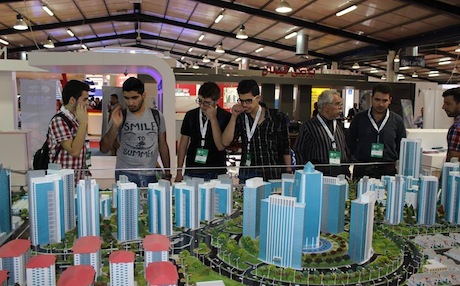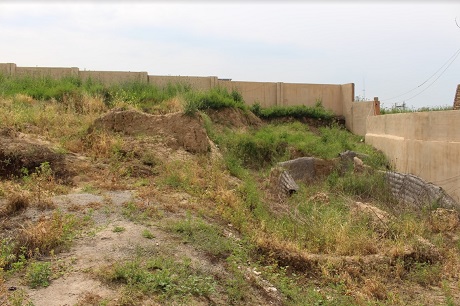ERBIL, Kurdistan Region – With a single incisor stabbing upwards out of a jutting jaw, the vacant eyes of a woman stare out of a glass cabinet in the Erbil Civilization Museum.
Her skull had been dug out of a clay-oven grave in Tell Nader, an Ubaid period (5500-4000 BC) archaeological site on the eastern edge of Erbil. She may be among the first people to call home the spot that claims to be the longest continuously inhabited city on the planet with evidence of life dating back at least 6,000 years.
 The skull of a woman excavated from Tell Nader, an Ubaid period site in Erbil, on display at the Erbil Civilization Museum, pictured April 29, 2019. Photo: Hannah Lynch / Rudaw
The skull of a woman excavated from Tell Nader, an Ubaid period site in Erbil, on display at the Erbil Civilization Museum, pictured April 29, 2019. Photo: Hannah Lynch / Rudaw
At the heart of Erbil sits the citadel, a UNESCO-recognized heritage site. For millennia it has served as a refuge and a symbol for the people who call this city home. Today, still under revitalization, it’s a tourist magnate with museums, cultural events, and picturesque spots crowded with selfie-takers.
Step outside its ancient heart and into the city that spirals outward from the citadel and you’ll discover a vibrant, young metropolis still finding its identity under the shadow of construction cranes that have swung back into business in recent months as the Kurdistan Region’s four-year financial crisis eases.
New highways, apartment blocks, and entire neighbourhoods are sprouting up, transforming the landscape seemingly overnight.
But is Erbil spiraling out of control?
“It is a confusing city between ancient and contemporary, between past and future, and between tradition and modernity,” says architect Bakhtyar Sadraddin Shareef, manager of Erbil’s urban planning department.
Massive population growth caused a flurry of construction, pitting the city’s history against its future in a tug-of-war to define its character.
Since 2003, the population has roughly doubled, says Erbil urban planner Shareef. “Of course this unforeseen pace of urban expansion would not be free of mistakes,” he said.
 Scale model of Erbil's Empire complex. File photo: Erbil International Fair 2013 / Empire World
Scale model of Erbil's Empire complex. File photo: Erbil International Fair 2013 / Empire World
One mistake was at the Tell Nader site, which was partially destroyed by the construction of roads and houses before its archaeological significance was recognized, though even then “the site remained under threat because of the very intensive building activity in the area,” wrote Greek archaeologist Dr. Konstantinos Kopanias in his 2013 report on the excavation led by the University of Athens.
Today, construction is underway on a sixth ring road, passing through urban sprawl and absorbing outlying villages into the capital. The route is part of the government’s development plan for the Kurdistan Region, Prime Minister Nechirvan Barzani explained at the groundbreaking ceremony last September.
That development comes a cost, warned Harvard University anthropologist Jason Ur, who directs the Erbil Plain Archaeological Survey. Commenting on the new road works, he tweeted it will “destroy cultural heritage; that’s the trade off with development.”
The rapid growth is also exceeding the limits of Erbil’s infrastructure, Shareef explained. Newly developed areas demand quickly built, efficient infrastructure that has “created a kind of formal sprawl” that is more expensive to service and depends on private cars rather than public transportation. “We missed out the principles of the sustainable city,” he said.
Erbil’s architectural history is another casualty of its accelerated drive forward. The look of the city is changing, not for the better some have argued as the traditional wisdom about how to build a home suitable for the sweltering hot summers and damp, chilly winters is ignored in favour of concrete-block edifices.
At the base of the citadel sits the central bazaar, surrounded by neighbourhoods like the Arab and Jewish quarters where much of the traditional yellow-ochre bricks are crumbling away. This ring of neighbourhoods is included in the city’s preservation plan as a buffer zone around the historic heart.
The city burst out of this inner circle in several major periods of expansion – the first of which occurred with the establishment of the state of Iraq in 1920 and the most recent with the economic boom the Kurdistan Region saw after Saddam Hussein was toppled.
“This was an interruption and a discontinuity in the city’s architecture and identity,” said Shareef.
New developments tend towards glitzy shopping centres, bland apartment blocks, or the grandiose monstrosities found in Dream City. The city is like a teenager, trying to discover itself, says Shareef. “Although it has potentials, Erbil as a capital city is struggling to establish its own distinguishing architectural identity while it is growing up.”
But it’s in danger of forgetting its roots.
 The Qaling Agha Hill archaeological site, located behind the Erbil Civilization Museum, pictured on April 29, 2019. Photo: Hannah Lynch / Rudaw
The Qaling Agha Hill archaeological site, located behind the Erbil Civilization Museum, pictured on April 29, 2019. Photo: Hannah Lynch / Rudaw
Back in the Erbil Civilization Museum, across the room from the skull, are two large clay pots that date from 3100-3500 BC, used to bury children. They were discovered in Qaling Agha Hill that sits just behind the museum. The hill was excavated in the 1960s and has since sat ignored. The half-decomposed body of a bird lies amid weathered mud walls overgrown with weeds. A few of the walls are haphazardly covered with woven straw mats.
Standing on the edge of the site, Lawin Jabar Osman, an archaeologist who works at the museum, sighs.
Her skull had been dug out of a clay-oven grave in Tell Nader, an Ubaid period (5500-4000 BC) archaeological site on the eastern edge of Erbil. She may be among the first people to call home the spot that claims to be the longest continuously inhabited city on the planet with evidence of life dating back at least 6,000 years.
 The skull of a woman excavated from Tell Nader, an Ubaid period site in Erbil, on display at the Erbil Civilization Museum, pictured April 29, 2019. Photo: Hannah Lynch / Rudaw
The skull of a woman excavated from Tell Nader, an Ubaid period site in Erbil, on display at the Erbil Civilization Museum, pictured April 29, 2019. Photo: Hannah Lynch / RudawAt the heart of Erbil sits the citadel, a UNESCO-recognized heritage site. For millennia it has served as a refuge and a symbol for the people who call this city home. Today, still under revitalization, it’s a tourist magnate with museums, cultural events, and picturesque spots crowded with selfie-takers.
Step outside its ancient heart and into the city that spirals outward from the citadel and you’ll discover a vibrant, young metropolis still finding its identity under the shadow of construction cranes that have swung back into business in recent months as the Kurdistan Region’s four-year financial crisis eases.
New highways, apartment blocks, and entire neighbourhoods are sprouting up, transforming the landscape seemingly overnight.
But is Erbil spiraling out of control?
“It is a confusing city between ancient and contemporary, between past and future, and between tradition and modernity,” says architect Bakhtyar Sadraddin Shareef, manager of Erbil’s urban planning department.
Massive population growth caused a flurry of construction, pitting the city’s history against its future in a tug-of-war to define its character.
Since 2003, the population has roughly doubled, says Erbil urban planner Shareef. “Of course this unforeseen pace of urban expansion would not be free of mistakes,” he said.
 Scale model of Erbil's Empire complex. File photo: Erbil International Fair 2013 / Empire World
Scale model of Erbil's Empire complex. File photo: Erbil International Fair 2013 / Empire WorldOne mistake was at the Tell Nader site, which was partially destroyed by the construction of roads and houses before its archaeological significance was recognized, though even then “the site remained under threat because of the very intensive building activity in the area,” wrote Greek archaeologist Dr. Konstantinos Kopanias in his 2013 report on the excavation led by the University of Athens.
Today, construction is underway on a sixth ring road, passing through urban sprawl and absorbing outlying villages into the capital. The route is part of the government’s development plan for the Kurdistan Region, Prime Minister Nechirvan Barzani explained at the groundbreaking ceremony last September.
That development comes a cost, warned Harvard University anthropologist Jason Ur, who directs the Erbil Plain Archaeological Survey. Commenting on the new road works, he tweeted it will “destroy cultural heritage; that’s the trade off with development.”
The rapid growth is also exceeding the limits of Erbil’s infrastructure, Shareef explained. Newly developed areas demand quickly built, efficient infrastructure that has “created a kind of formal sprawl” that is more expensive to service and depends on private cars rather than public transportation. “We missed out the principles of the sustainable city,” he said.
Erbil’s architectural history is another casualty of its accelerated drive forward. The look of the city is changing, not for the better some have argued as the traditional wisdom about how to build a home suitable for the sweltering hot summers and damp, chilly winters is ignored in favour of concrete-block edifices.
At the base of the citadel sits the central bazaar, surrounded by neighbourhoods like the Arab and Jewish quarters where much of the traditional yellow-ochre bricks are crumbling away. This ring of neighbourhoods is included in the city’s preservation plan as a buffer zone around the historic heart.
The city burst out of this inner circle in several major periods of expansion – the first of which occurred with the establishment of the state of Iraq in 1920 and the most recent with the economic boom the Kurdistan Region saw after Saddam Hussein was toppled.
“This was an interruption and a discontinuity in the city’s architecture and identity,” said Shareef.
New developments tend towards glitzy shopping centres, bland apartment blocks, or the grandiose monstrosities found in Dream City. The city is like a teenager, trying to discover itself, says Shareef. “Although it has potentials, Erbil as a capital city is struggling to establish its own distinguishing architectural identity while it is growing up.”
But it’s in danger of forgetting its roots.
 The Qaling Agha Hill archaeological site, located behind the Erbil Civilization Museum, pictured on April 29, 2019. Photo: Hannah Lynch / Rudaw
The Qaling Agha Hill archaeological site, located behind the Erbil Civilization Museum, pictured on April 29, 2019. Photo: Hannah Lynch / RudawStanding on the edge of the site, Lawin Jabar Osman, an archaeologist who works at the museum, sighs.
“It’s very important. I don’t know why nobody cares about it,” she says.




Comments
Rudaw moderates all comments submitted on our website. We welcome comments which are relevant to the article and encourage further discussion about the issues that matter to you. We also welcome constructive criticism about Rudaw.
To be approved for publication, however, your comments must meet our community guidelines.
We will not tolerate the following: profanity, threats, personal attacks, vulgarity, abuse (such as sexism, racism, homophobia or xenophobia), or commercial or personal promotion.
Comments that do not meet our guidelines will be rejected. Comments are not edited – they are either approved or rejected.
Post a comment